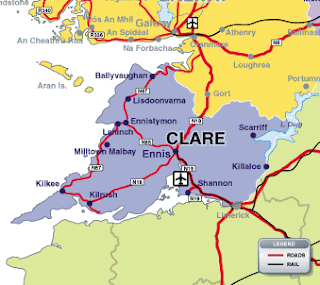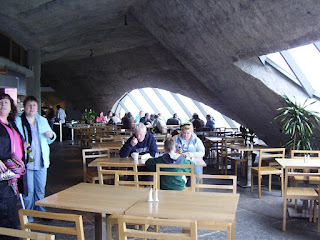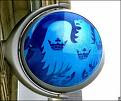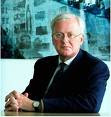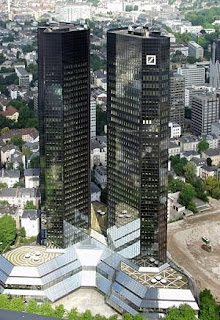 Radcliffe Camera
Radcliffe Camera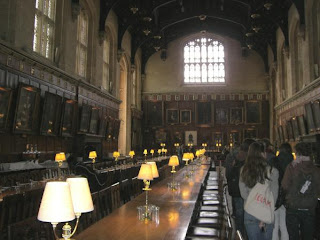 Christchurch Dining Hall
Christchurch Dining Hall18 Miles from Castle Caldwell lays the city of the "Dreaming Spires", the historic University City of Oxford. For all its attractions it can be a difficult city for the first time visitor to find their way around and see the parts which capture the athmosphere and sense of purpose of this ancient seat of learning. What visitors find here is not a single University campus but a jumble of colleges, libraries, museums, fine shops and other buildings. Added to this, Oxford City Council actively tries to preserve the character of the historic centre by discouraging cars and through traffic and encouraging walking, cycling and public transport. Car restrictions are rigorously enforced, including by remote cameras, so if not arriving by train or coach it is best to use the “Park and Ride” facilities on the outskirts of Oxford or the car parks on the edge of the centre. So this
ROT (Reduced Oxford Tour) is in the traditions of our
RLT Reduced London Tour http://daithaic.blogspot.com/2007/09/day-in-london.html and its aim is to show you the real Oxford as cheaply as possible and keep you out of overpriced and tacky tourist attractions. But, before the
ROT, some history to put it all into context.
 "The Dreaming Spires"
"The Dreaming Spires"Oxford, is famous the world over for its University and place in history. For over 800 years, it has been a home to royalty and scholars, and since the 9th century an established town, although people are known to have lived in the area for thousands of years. Nowadays, the city is a bustling cosmopolitan town, still with its ancient University, but home also to a growing hi-tech community. Many businesses are located in and around the town, whether on one of the Science and Business Parks or within one of a number of residential areas.
The origins of Oxford are not actually known with any certainty, being as they are, shrouded in the mists of time, but various ideas have been submitted (and disputed) regarding its genealogy. Medieval historian, John Rous wrote in his 1490 work, “Historium Regum Angliae”, that Oxford was originally King Mempricius' city, Caer-Memre, built on the River Thames somewhere between 1400 and 1500 BC. However, other historians from Rous' time were more inclined to support the popular legend that Oxford was in fact founded by the Trojans, after they landed on British soil in around 1100 BC.
 View towards Magdalen
View towards MagdalenAlthough the town of Oxford itself supported the Parliamentary cause in the English Civil War, the powerful University was staunchly Royalist and, as a result, the city served as a home base for King Charles during the period. Specifically, the University housed King Charles at Christ Church College between 1642 and 1646, while Queen Henrietta Maria stayed at Merton.
Firmly established as an academic centre by the 13th century, Oxford was drawing students from across Europe for studies focused on houses established by the Dominicans (1221), Franciscans (1224), Carmelites (1256), and Augustinians (1267). History records a rocky relationship between the city of Oxford and the University of Oxford. Resentment towards the University on the city's part stemming, not least, from the scholars' legal precedence over the town. Until the 20th century the Chancellor of the University had the legal right to trial over townsfolk, and it was only in 1974 that the university lost the right to place its own representatives on the Oxford City Council. In fact, the 'Town and Gown' of Oxford have experienced a rather violent past with one of the most infamous outbreaks of rioting happening on St. Scholastrica's Day (February 10) in 1354.
 Christchurch Cloisters
Christchurch Cloisters Merton Lane
Merton LaneOxford is the oldest university in the English-speaking world and lays claim to nine centuries of continuous existence. As an internationally renowned centre for teaching and research, Oxford attracts students and scholars from across the globe, with almost a quarter of the students from overseas. More than 130 nationalities are represented among a student population of over 18,000. Oxford is a collegiate university, with 39 self-governing colleges related to the University in a type of federal system. There are also seven Permanent Private Halls, founded by different Christian denominations. Thirty colleges and all halls admit students for both undergraduate and graduate degrees. Seven other colleges are for graduates only; one has Fellows only, and one specializes in part-time and continuing education.
 Oxford; Colleges & Halls
Oxford; Colleges & HallsThe early seats of learning were monastic foundations and it is this monastic model which is so effectively reflected in the layout and operations of the colleges today which have cloisters, a chapel and a dining hall and college gardens or water meadows by the Thames (called the Isis where it flows through Oxford) or the Cherwell. What is also confusing for visitors is that the colleges don’t look like campuses elsewhere. In Oxford or Cambridge the teaching method is not the same as at other universities with few lecture halls. Rather students are taught in small tutorial groups or one to one by tutors in their rooms. Also students can attend tutorials or use facilities at several colleges not just their own. It is the uniqueness of this teaching method, the size and tradition of the academic community, the great resources and facilities available which makes an education at Oxford (and Cambridge) so special and so prized in the academic world. So now let us embark on the
ROT!
For the
ROT I’m going to restrict your tour to a large and small college, Magdalen and Brasenose and the centre of the University area but you could just as well take other colleges (Christchurch and Balliol) and do a similar tour. To do this tour if you are travelling by car you come into Oxford on the A420 which leads to the M40 Motorway and London. Park in the Park & Ride on the outskirts or before coming to Magdalen Bridge and its roundabout, park in the Council “pay and display” car park signposted on the right. Now take a gentle stroll towards the centre across the Cherwell on Magdalen Bridge into High Street. Ahead of you on the right you will see the tower and buildings of Magdalen College, on the left the Oxford Botanic Gardens and as you cross over the Cherwell you will see a boathouse with punts for hire.

 Punts on the Cherwell
Punts on the CherwellMagdalen College (pronounced 'Maudlin') has a reputation as one of Oxford's most beautiful colleges, and rightly so. The famous Great Tower (by William Reynolds) stands sentinel beside Magdalen Bridge and inside the college you will find peaceful cloister gardens, riverside walks and a deer park where a herd of fallow deer has been kept for over 300 years. Each year on 1st May, Magdalen is the scene of the beginning of Oxford's traditional May Morning celebrations. Crowds gather on Magdalen Bridge to welcome in the spring and, at 6am sharp, Magdalen Choristers sing madrigals to the hushed crowds below.
 Magdalen Tower
Magdalen TowerMake sure to go into the College (An admission fee is payable) and follow the guide to see the chapel, dining hall, cloisters and the delightful deerpark and gardens at the back of the college. There is also a pleasant well run snack bar (called a Buttery in Oxford) by the river where you can watch the punts go by. The River Cherwell reaches the northern outskirts of Oxford and runs south on the eastern edge of north Oxford town centre. Near Summertown it passes the Victoria Arms (or "Vicky Arms"), a popular riverside pub at Marston and then under a modern bridge that is part of Marston Ferry Road. A little further south, the Cherwell passes Wolfson College (a graduate college of Oxford University), the Cherwell Boathouse (where punts can be hired) and the playing fields of the Dragon School. Next is Lady Margaret Hall, one of the previously all-women's Oxford colleges.
 Magdalen College Chapel
Magdalen College Chapel Magdalen Cloisters
Magdalen CloistersThe river is then flanked by University Parks and passes under Rainbow Bridge. Parson's Pleasure and Dame's Delight used to provide nude bathing facilities for male and female bathers respectively, but both are now defunct. Below the Parks, the river splits into up to three streams, with a series of islands. One is Mesopotamia, which is a long thin island just south of the Parks with a path that provides a pleasant walk. At the northern end, there are punt rollers next to a weir. St Catherine's College is on the largest island formed by the split of the river. It also flows past Magdalen College.
 Punting on the Cherwell
Punting on the CherwellThe river conjoins again into two streams close together to flow under Magdalen Bridge. The river splits again past the bridge. To the west is the Oxford Botanic Garden. The river then skirts Christ Church Meadow before flowing into the River Thames (or Isis) through two branches. On the island in between these branches are many of the college boathouses for rowing on the Thames. In summer, punting is very popular on the Oxford stretch of the Cherwell. (A punt is a long flat bottom boat which is propelled by means of a pole pushed against the river bed.) Punts are typically hired from a punt station by Magdalen Bridge or the Cherwell Boathouse (just to the north of the University Parks). It is possible to punt all the way from the Isis, north past the University Parks, and out beyond the ring road.
After Magdalen continue up the High Street and turn right through a pedestrian lane into Radcliffe Square. Radcliffe Square lies at the very heart of the old University. The round building in the centre is the Radcliffe Camera which was funded from the estate of the Royal Surgeon Dr John Radcliffe. The building was designed by James Gibbs and was completed in 1749. Originally conceived as a library of science and medicine, it is now part of the Bodleian Library and houses a collection on History and English Literature.
One of the best views of Oxford, All Souls and the Radcliffe Camera in particular, can be obtained from the top of the University Church of St Mary's spire. The University Church has been in existence since the late 13th century. In the early days of the University, the Church was a centre of administration and teaching, with the side chapels acting as lecture theatres where students studied mainly Theology. In 1556, it hosted the trial of the protestant Bishops Ridley, Cranmer and Latimer. The “Oxford Martyrs” where subsequently burnt at the stake for heresy by the Catholic Queen of England, Mary Tudor known to history as Bloody Mary. The Church is open every day and visitors can climb up the 127 stairs to the top of the spire to get another classic aerial view of Radcliffe Square and the spires of Oxford. Entrance to the church and spire is via Radcliffe Square. Surprisingly, Oxford is not well endowed with good restaurants but there is an excellent and good value Café in the cellar of St. Mary’s Church which uses organic local produce and has good loos. From the top of St Mary’s looking out over Radcliffe Square you have All Souls College on your right and the next one we are going to visit Brasenose on your left.
 St. Mary the Virgin
St. Mary the VirginThe College of All Souls of the Faithful Departed, of Oxford, was founded by Henry VI and Henry Chichele (fellow of New College and Archbishop of Canterbury), on 20 May 1438. The Statutes provided for the Warden and forty fellows - all to take Holy Orders; twenty-four to study arts, philosophy and theology; and sixteen to study civil or canon law. Today the College is primarily an academic research institution at the University of Oxford, having strong ties to the public domain. Traditionally, there are no undergraduate members.
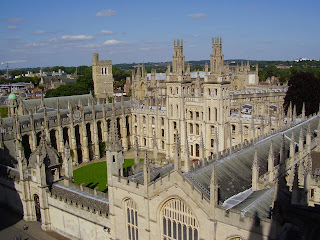 All Souls from St. Mary's
All Souls from St. Mary'sWhen you come down from St. Mary’s go to your left into one of the smaller colleges, Brasenose. The name of the College has always fascinated visitors to Oxford, and there have been several interpretations of it. The most likely is that it refers to a “brazen” (brass or bronze) door knocker in the shape of a nose. In the 1330s there was a migration of rebellious students from Oxford to Stamford in Lincolnshire, and one of the ringleaders was from Brasenose Hall. In due course the rebellion was suppressed, the king ordering the students to return to Oxford. In 1890 a house in Stamford was offered for sale; it was called “Brasenose”, and had an ancient door knocker, dated to the twelfth century. Brasenose College purchased the house for the sake of that door knocker, which was brought to Oxford and now hangs over the high table in Brasenose Hall. The College historians of the 1890s were convinced that the fourteenth century students of Brasenose Hall took the knocker from which they derived their name to Stamford, and that it had been restored to its rightful home at last.
 Brasenose
BrasenoseNoses have been used as symbols for Brasenose College throughout its history. More than one has been placed over the main door and they can be found in the glass in Hall. The Archives have a carved nose once attached to the College Eight, a nose tie pin of the 1870s, and one of the nose pipes sold by a local tobacconist and smoked by Brasenose undergraduates in the years before the First World War. For a small college it has had many famous graduates ranging from Archbishops of Canterbury to Michael Palin. Leaving Brasenose turn left past the Radcliffe Camera towards Broad Street and you will come to the Bodleian Library and Sheldonian Theatre and pass the Bridge of Sighs.
 Bodleian Library
Bodleian LibraryThe Bodleian Library is the main research library of the University of Oxford. It is also a copyright deposit library and its collections are used by scholars from around the world. The buildings within the central site include Duke Humfrey's Library above the Divinity School, the Old Schools Quadrangle with its Great Gate and Tower, the Radcliffe Camera, Britain’s first circular library, and the Clarendon Building. In addition, the Bodleian consists of nine other libraries, in separate locations in Oxford: the Bodleian Japanese Library, the Bodleian Law Library, the Hooke Library, the Indian Institute Library, the Oriental Institute Library, the Philosophy Library, the Radcliffe Science Library, the Bodleian Library of Commonwealth and African Studies at Rhodes House and the Vere Harmsworth Library.
On your right you will see The Bridge of Sighs which joins the two sections of Hertford College located on either side of New College Lane. Modeled on the famous Ponte dei Sospiri in Venice, it has become one of Oxford's most photographed buildings and is well known from “Inspector Morse” and other programmes and films. But its construction was vehemently opposed when it was built in 1913, not least by the Fellows of New College who thought it would spoil the views of their college from the Sheldonian Theatre. The original bridge in Venice gets its name from the sighs of the prisoners being led to their execution.
 The Bridge of Sighs
The Bridge of Sighs The Sheldonian Theatre is the centre for University ceremonials and another creation of Sir Christopher Wren. This is well worth a visit, not just to see the Vice Chancellor's elaborately carved throne and painted ceiling, but also to take in the spectacular aerial views of Oxford's spires and domes from the rooftop cupola. The Broad Street entrance to the Sheldonian Theatre is notable because of the carved heads, or terms, that tower above the railings. Often referred to as the twelve Caesars or Apostles, they are actually anonymous but, nonetheless, curiously photogenic!
 Sheldonian Theatre
Sheldonian Theatre Ashmolean Museum
Ashmolean MuseumNow walk past the Sheldonian and Blackwell’s famous University bookshop on Broad Street and turn right into St Giles at the top where it meets Cornmarket. Here you will see the Monument of the English Martyrs in St Giles. This is near the spot where the Protestant Bishops Latimer, Ridley and Cranmer (the Oxford Martyrs) were burned at the stake in 1555 and 1556 by Catholic Queen Mary. Head up St. Giles for 200 metres past the Randolph Hotel and the Ashmolean Museum on your left and Balliol and Keble Colleges on your right until on your left past St. Cross College you will come to your final destination with the promise of a traditional Morrel’s ale in the back room of the pub everybody in Oxford knows as the Bird and Baby but which the sign over the door actually calls the “Eagle and Child”!
 JRR Tolkien
JRR Tolkien CS Lewis
CS Lewis Charles Williams
Charles WilliamsThis building dates from the sixteenth century and is Grade II listed. It is popularly known as the “Bird & the Baby”, and has been a pub since 1650. Wellington Place runs along the north side of the building, and Eagle & Child Passage runs through the pub itself on the south side. From the 1930s to the 1960s the Inklings (including C.S. Lewis and J.R.R. Tolkien) met in the “Rabbit Room” at the back of this pub. The Inklings were a gathering of friends -- all of them British, male, and Christian, most of them teachers at or otherwise affiliated with Oxford University, many of them creative writers and lovers of imaginative literature -- who met usually on Thursday evenings in C.S. Lewis's and J.R.R. Tolkien's college rooms in Oxford during the 1930s and 1940s for readings and criticism of their own work, and for general conversation. "Properly speaking," wrote W.H. Lewis, one of their number, the Inklings "was neither a club nor a literary society, though it partook of the nature of both. There were no rules, officers, agendas, or formal elections."

An overlapping group gathered on Tuesday (later Monday) mornings in various Oxford pubs, usually but not always the Eagle and Child, better known as the Bird and Baby, between the 1940s and 1963. These were not strictly Inklings meetings, and contrary to popular legend the Inklings did not read their manuscripts in the pub. What they have left behind are some of the most enduring works of 20th Century English literature including The Hobbit, The Lord of the Rings, The Silmarillion, The Chronicles of Narnia, War in Heaven, Many Dimensions, and Descent into Hell and Mere Christianity.
 Inklings Snug - the “Rabbit Room”
Inklings Snug - the “Rabbit Room” Bird and Baby
Bird and Baby To get an idea of the Oxford of the ‘50s and the world of the “Inklings”, watch the excellent movie “Shadowlands” where Anthony Hopkins plays C.S. Lewis. But also make sure you have a drink in the back room surrounded by their memorabilia and photos. For you have earned your drink having completed the
ROT in such good style! If you are staying longer in Oxford there is much more to see; many more wonderful colleges, numerous museums and art galleries including the Ashmolean, Oxford and Pitts Rivers museums, excellent shopping, the covered market, the Oxford Canal and the riverside and water meadow walks and the rich theatrical, musical and cultural life of the town in the evenings. But whether you are staying or moving on I hope you will feel that the
ROT has given you an insight into a town of dreaming spires and magnificent warm sandstone buildings which is rather special and rather wonderful
 See also;
See also;
Ashmolean Museum, Oxford
http://daithaic.blogspot.com/2009/11/oxfords-ashmolean-museum.htmll
Oxford Rambles
http://daithaic.blogspot.com/2010/05/oxford-rambles.html
Pitt Rivers Museum
http://daithaic.blogspot.com/2010/09/pitt-rivers-museum-oxford.html
Location: Oxfordshire, England Oxford Canal
Oxford Canal travel
travel
